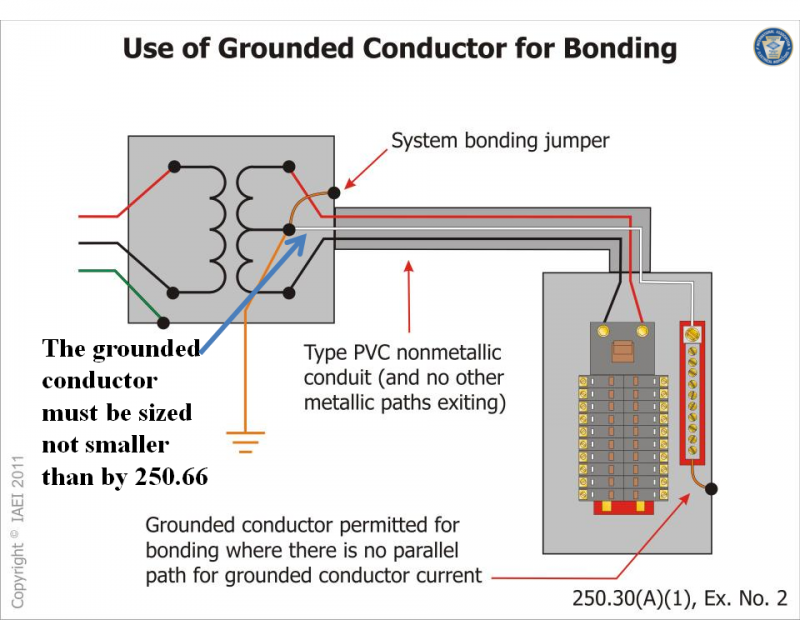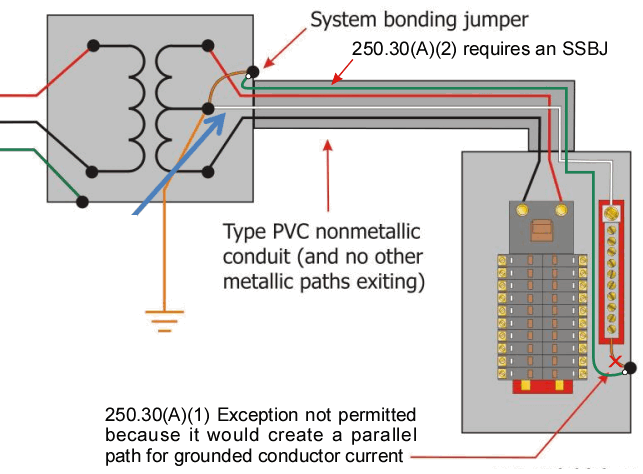________________________________________________________________
5-85 Log #3255 NEC-P05
Final Action: Accept in Principle
(250.30(A)(1) Exception No. 2)
________________________________________________________________
Submitter: Mark R. Hilbert, MR Hilbert Electrical Inspections & Training
Recommendation: Revise text to read as follows:
Exception No. 2: For installations made in compliance with previous editions
of this Code that permitted such connections, A a system bonding jumper at
both the source and the first disconnecting means shall be permitted if doing so
does not establish a parallel path for the grounded conductor. If a grounded
conductor is used in this manner, it shall not be smaller than the size specified
for the system bonding jumper but shall not be required to be larger than the
ungrounded conductor(s). For the purposes of this exception, connection
through the earth shall not be considered as providing a parallel path.
Substantiation: This is one of two proposals I have submitted to allow CMP-
05 to consider an issue that resulted from the revision and reorganization of
250.30 in the last cycle. The other proposal is submitted to 250.30(A)(2). If this
proposal is accepted, my proposal to 250.30(A)(2) should be rejected.
Exception No. 2 to 250.30(A)(1) permits a system bonding jumper to be
installed at the source and first disconnecting means if doing so does not
establish a parallel path for the grounded conductor. However, the current text
in 250.30(A)(2) essentially eliminates the application permitted by Exception
No. 2. If it was the intent to not allow the grounded conductor to be used in
this manner (as the ground fault return path where doing so does not establish a
parallel path) then this proposal could be accepted and my proposal to
250.30(A)(2) would be rejected.
Panel Meeting Action: Accept in Principle
Revise the exception to read as follows:
250.30(A)(1) Exception No. 2
Exception No. 2: If a building or structure is supplied by a feeder from an
outdoor transformer, Aa system bonding jumper at both the source and the first
disconnecting means shall be permitted if doing so does not establish a parallel
path for the grounded conductor. If a grounded conductor is used in this
manner, it shall not be smaller than the size specified for the system bonding
jumper but shall not be required to be larger than the ungrounded
conductor(s). For the purposes of this exception, connection through the earth
shall not be considered as providing a parallel path.
Panel Statement: See the panel statements on Proposal 5-84 and Proposal
5-88. The revised text provides for the limited case where the grounded
conductor can be bonded at the source of a separately derived system and in a
building or structure served and continues to prohibit parallel paths. The panel
action on proposal 5-88 allows the elimination of the supply-side bonding
jumper where the grounded conductor can serve as the ground fault return path.
Proposal 5-244c adds an exception to 250.32(B) to require the grounded
conductor to be connected to the equipment grounding conductors, grounding
electrode conductor and the first disconnecting mean enclosure when this
exception is used.
Number Eligible to Vote: 16
Ballot Results: Affirmative: 16




